By Marc Stern
Whenever there’s a blizzard and super cold, it seems like stories always pop up of people marooned in their cars for days who are found just too late. For whatever reasons, they ventured out into the raging blizzard ill-prepared for the challenges and ended up paying a hefty price.
It’s not a position that anyone should be in. Indeed, there are things you can do to keep from being in that position, starting with some of pieces of advice:
- Never let your vehicle’s fuel tank get below the halfway point in the winter;
- Make sure that your car is tuned well for the winter and that all fluids are up to date;
- Make sure your vehicle is running on winter tires; all-season tires just don’t cut it.
- Make sure you tell others of your intended route and/or destination when traveling alone or on questionable roads and in questionable weather conditions.
Next, round up a good, sturdy box and line it with plastic or use a rubberizing agent that you can paint on the inside of the box (the one that’s advertised by keeping a boat afloat) to make sure the box is waterproof. Or, you can buy a waterproof canister or box to serve the same purpose, holding all of the items you need to make a go of lousy weather.
Here’s a list of the 10 essential things that you should put into and keep in your trunk during rough winter weather:
1. A shovel or entrenching tool
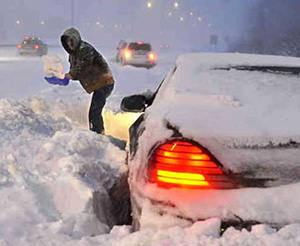 In heavy snow, a shovel is a handy tool to have around. You can use it to dig out of snow drifts, clean out the areas around your vehicle’s wheels and keep your exhaust system free, so exhaust fumes stay outside, instead of coming inside. The shovel should be a medium- to heavy-duty collapsible shovel. The handle should telescope to open or close so that the shovel doesn’t take up too much space and, if possible, the blade should swing into the shovel for stowage. If you can’t find this type of shovel, then consider a soldier’s friend, the steel-bladed entrenching tool. Yes, it is a tad small, but, it is also tough enough to tackle ice, hard-frozen earth, trees, bushes and just about anything else. If you need to build a fire, you can also use it as a makeshift ax, though it will take time to hack through larger wood. Avoid light-duty collapsible shovels as they do tend to crumble just when you need a tough shovel.
In heavy snow, a shovel is a handy tool to have around. You can use it to dig out of snow drifts, clean out the areas around your vehicle’s wheels and keep your exhaust system free, so exhaust fumes stay outside, instead of coming inside. The shovel should be a medium- to heavy-duty collapsible shovel. The handle should telescope to open or close so that the shovel doesn’t take up too much space and, if possible, the blade should swing into the shovel for stowage. If you can’t find this type of shovel, then consider a soldier’s friend, the steel-bladed entrenching tool. Yes, it is a tad small, but, it is also tough enough to tackle ice, hard-frozen earth, trees, bushes and just about anything else. If you need to build a fire, you can also use it as a makeshift ax, though it will take time to hack through larger wood. Avoid light-duty collapsible shovels as they do tend to crumble just when you need a tough shovel.
2. A good flashlight and fresh batteries
This one is a no-brainer. A working flashlight is essential in heavy weather. The batteries should also be new. Whether you are changing a tire or just using it to illuminate a small camp stove on which you are heating some water, you do need the proper illumination. However, you should note that cold does sap batteries so you may gain on one end, if it is cold enough you will lose a bit on the other. The only other thing about LEDs versus standard flashlight bulbs is that you may need a specially focused flashlight lens for full output. And, there may be some tweaks to the curvature of the LED mount itself. One more caveat: a good one from a weight standpoint is that many flashlights use AA or AAA batteries which are far lighter than the bulkier D-celled batteries of just a few years ago.
Related: Which Batteries Are Best for Survival Situations?
3. Tools
Without even basic tools, if you get stuck in a blizzard you will find things can turn against you very quickly. You cannot turn screws with a screwdriver, and you need a wrench or wrench-like device to move stubborn nuts. The basic toolkit should include a multi-tool, like a Leatherman Wave or something similar (a Swiss Army knife is also good), so you can have all the tools you need at hand. The problem is that if you need two pliers or two slotted screwdrivers, you are out of luck. The solution is adding a backup set of pliers, a slotted (straight edge) screwdriver, a Phillips screwdriver and, perhaps, a compact set of ratchet wrenches. The set of ratchet wrenches allows you to have a variety of socket sizes to handle a variety of nut sizes. Two more useful tools to add to this collection are a spinner lug wrench (four-way) and, believe it or not, a hacksaw. If you run into frozen nuts or that won’t budge, a hacksaw is just the ticket. It keeps you from stripping the head and gives you a quick removal option. And, it is not a bad idea to include a ratchet-style screwdriver and heads in the kit as well so you can handle the variety of specialized connectors in today’s vehicles.
4. Butane lighter
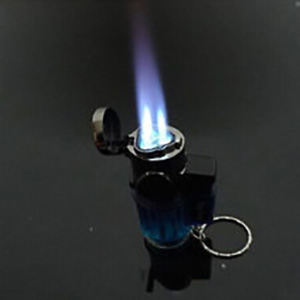 It’s pretty obvious why you would want to have a lighter. You can use it to heat a key so that you can open a frozen door lock (hold the key with the pliers). The lighter is also a good idea if you have to build a signal fire – if you are stuck in the middle of nowhere and your vehicle’s battery dies, then a signal blaze will show rescuers where you are. The butane is natural option for this because it’s lightweight and doesn’t take up much space, but it does a tremendous job when needed.
It’s pretty obvious why you would want to have a lighter. You can use it to heat a key so that you can open a frozen door lock (hold the key with the pliers). The lighter is also a good idea if you have to build a signal fire – if you are stuck in the middle of nowhere and your vehicle’s battery dies, then a signal blaze will show rescuers where you are. The butane is natural option for this because it’s lightweight and doesn’t take up much space, but it does a tremendous job when needed.
5. Wool or space blankets
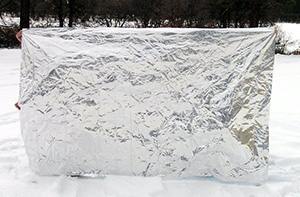 Including wool blankets is essential for several reasons. First, it is a way to stay warm (you can’t run your vehicle out of fuel to stay warm, so a blanket is a good idea to have on hand). The space blanket serves the same purpose. Second, if you have to change a tire, it can be used as a ground tarp. It keeps you from getting soaked through and colder than you might already be. It also lets you keep the tools and parts out of the snow. Third, the blanket can help your wheels if there is need for added traction getting out of a snowbank, although, admittedly, it is a brief traction assistant. Still, if wedged right, it might enable you to move your vehicle up and out of a rut. Fourth, the blanket is a way to keep warm if you are outside the vehicle for any reason (freeing the tailpipe, for example).
Including wool blankets is essential for several reasons. First, it is a way to stay warm (you can’t run your vehicle out of fuel to stay warm, so a blanket is a good idea to have on hand). The space blanket serves the same purpose. Second, if you have to change a tire, it can be used as a ground tarp. It keeps you from getting soaked through and colder than you might already be. It also lets you keep the tools and parts out of the snow. Third, the blanket can help your wheels if there is need for added traction getting out of a snowbank, although, admittedly, it is a brief traction assistant. Still, if wedged right, it might enable you to move your vehicle up and out of a rut. Fourth, the blanket is a way to keep warm if you are outside the vehicle for any reason (freeing the tailpipe, for example).
6. Dry food supplies and water
Most people never think about it, but, there could be a time when if you are stuck in your car for several days (or at least more than one, depending on the area) you will need food. In the event of this, it’s a good idea to take a page from your prep plans. Make sure you have adequate supplies of dried, high-energy, low-residue foods (to keep nature at bay as long as possible) available so you can keep your energy up. It might not be a bad idea to keep some trail mix in the passenger compartment for not only snacking, but also as a supplement to the food you carry in the trunk. And, while it is possible to melt snow for water when you are stuck, you honestly have no idea where the water that’s in the snow originally came from – acid rain, pollution, smokestack waste, who knows? That’s why it is a good idea to lay in a 24-pack of water bottles to go along with the rest of your gear. Why water bottles and not water filtration? It’s simple; water filtration usually requires heat which is in rather short supply with your car stuck in a blizzard. You can’t set up a stove in the passenger compartment without ensuring the windows are open, so you won’t poison yourself on fumes, especially if the wind and cold are brutal enough. And, trying to set up and tend a wood fire in the snow when everything is either frozen or drenched when it’s thawed is not a good use of your time.
Related: How to Make 2400 Calorie Emergency Ration Bars Designed to Feed You for a Full Day
7. Cash
Let’s say you have access to a nearby convenience store where you can get stuff and maybe a container of fuel to keep your vehicle running. Let’s also say the area loses power for a time and that when you try to use your credit or debit cards, you find that there’s no juice for the reader. If you depend on plastic, you are out of luck until the power comes back up. However, if you have a variety of cash, a $20 bill, a $10 bill some $1 bills and change, you can just put down what you need and make your purchases. And, if you are in an area where they may require ID to use a credit or debit card (always a good idea for the shopkeeper and your sake), and there’s no way to check the identification, then cash is the only way to go.
8. Traction aids
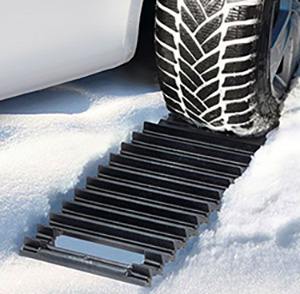 There’s an impressive variety of traction aids out there that can help you get your vehicle out of a rut or snowbank. For example, you can buy a set of rubberized traction strips that you plant in front and under the driving tires – front or rear – so that you can quickly pull up and out of the obstacle. You can also purchase track treads which are metal devices that serve the same purpose. If you can jack up your vehicle, you can add sets of snow clips. Two-chain devices that strap around your vehicle’s wheels and tires, they serve as mini-snow chains and add traction. It is a
There’s an impressive variety of traction aids out there that can help you get your vehicle out of a rut or snowbank. For example, you can buy a set of rubberized traction strips that you plant in front and under the driving tires – front or rear – so that you can quickly pull up and out of the obstacle. You can also purchase track treads which are metal devices that serve the same purpose. If you can jack up your vehicle, you can add sets of snow clips. Two-chain devices that strap around your vehicle’s wheels and tires, they serve as mini-snow chains and add traction. It is a
good idea to use four sets per driving wheel. You should remove them after
you are on the road again as they provide a rough ride and set up odd resonances that can put too much strain on your front end or rear end pieces. If you 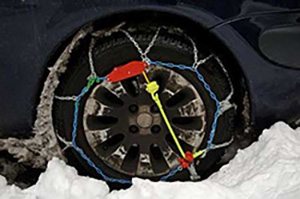 need them, then use full chains and leave them on. Here’s a good idea: keep a 20-pound bag of cat sand in the trunk. Not only does it provide a bit of weight, but it also is perhaps the best traction aid out there as it outperforms road sand and salt. It is clay-based and not only grips but also stays relatively dry for extra traction because ice doesn’t form.
need them, then use full chains and leave them on. Here’s a good idea: keep a 20-pound bag of cat sand in the trunk. Not only does it provide a bit of weight, but it also is perhaps the best traction aid out there as it outperforms road sand and salt. It is clay-based and not only grips but also stays relatively dry for extra traction because ice doesn’t form.
Related: How to Build an EMP Emergency Car Bag
9. Flares or emergency triangles
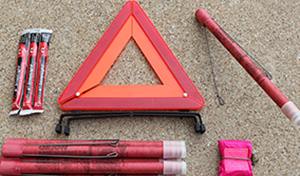 Honestly, it is a good idea to keep both in your trunk. The flares are there to provide high visibility when you need it. Since they can be stored and sparked off as needed, they are quite convenient to use. Their form factor also means you can store many of them in a small space quite safely. The emergency triangles are great because you can set them up a distance behind your vehicle so that oncoming vehicles can see your car. If they become snow-covered, you can recover them and replace them for safety.
Honestly, it is a good idea to keep both in your trunk. The flares are there to provide high visibility when you need it. Since they can be stored and sparked off as needed, they are quite convenient to use. Their form factor also means you can store many of them in a small space quite safely. The emergency triangles are great because you can set them up a distance behind your vehicle so that oncoming vehicles can see your car. If they become snow-covered, you can recover them and replace them for safety.
10. A car phone charger or a small prepaid portable phone
Let’s face it unless you keep off the smartphone and away from things like Twitter, Facebook, Instagram and YouTube, your smart device’s battery life will be very short-lived. This is where the prepaid cellphone is excellent. You keep it in plastic until you need it and then open it up and viola you are on the phone. They are so inexpensive as compared with smartphones that you can purchase more than one to make sure you have communications capability. Of course you should always keep in your car a phone charger that can be charged from your car.
That about covers it. Of course, you will probably think of some stuff to add to your box. However, even if you just rely on the listing here, you will find that you are ready to go and survive even the nastiest that nature can hand out.
You may also like
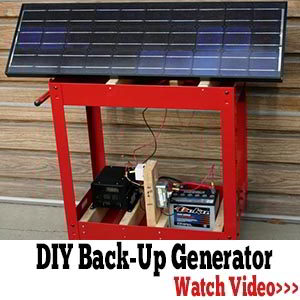 Top 5 Awesome Bug Out Vehicles You Can Actually Afford
Top 5 Awesome Bug Out Vehicles You Can Actually Afford
You Will Not Survive An EMP Strike Without This (Video)
8 Tips To NEVER Get Your Car Stolen (from An Ex-Thief – Guest Post)
Top 10 Vehicles for Your EMP Survival
How to Conceal Weapons in Your Vehicle

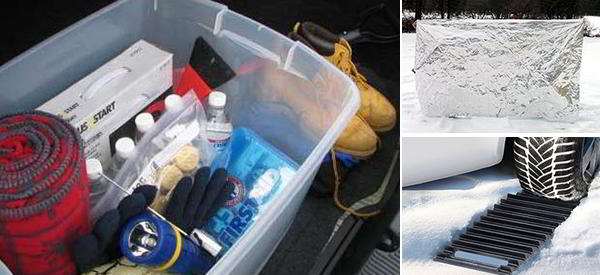













What do you do when your bottled water freezes?
O[en water bottle and pour a little out. Freeze in your freezer first to see how much space you need before bottle bursts. Which is why I carry 4 bottles…because some is already gone.
I also carry a can with candles….ar least 3 candles, a solar blanket, a wool blanket and a sleeping bag. If you travel with pets, put extra fleece in vehicle to wrap around them….hopefully in carrier/s. Plus a small bowl for water.
Experts recommend carrying tea lights (or larger candles in containers) and matches or cigarette lighters (but butane does not work well in cold weather) in your kit (enclose in a plastic bag to keep dry). Lighting just one candle on your dashboard can supply an unexpected amount of heat. Just be sure to close the vents and crack open a window.
You take one bottle before it is frozen and put it inside your clothing next to your body. Then, before that bottle runs out you do the same with another. If you have canned food that might freeze you do the same thing. You decide at breakfast what you are going to have to lunch, lunch for dinner, bedtime for breakfast. Putting the can in will be cold at first, but if you do it while you are active, it will quickly warm up. Don’t put it next to your skin if it is frozen or it will stick to your skin, especially if you are even just a little bit sweaty. Remember the movie? You won’t want to touch metal with bare skin when it is really cold. We used the water thawing and meal selection process back in the old days of c-rations in the Marine Corps. Experience learned the hard way on the march back from the Reservoir.
First, assuming you placed some in your main cabin, under-seat for starters, put the plastic bottle either within your crotch area or under your armpits for about 30 mins (97 degrees), then you should be able to drink a portion. And if you’re with a partner, place toes/fingers under the partner’s armpits as well if your toes are frozen–may be smelly and unseemly, but hey, your lives are at stake here. Your extremities are the first to go, where your body preserves the heart and lung functions at all costs (that’s why we crouch and sleep inward preserving our “core”). Learned this under cold-weather training in Iceland.
I guess I should explain myself better. Where I live it is -10* this morning. If I had a case of water bottles in my car they would be frozen solid. I always wonder when I read these articles what you should do in cases like this.
I carry extra water in one of those cheap foam ice chests. It is surprising how much it insulates the water from outside temperatures. I haven’t tried it at -10 but during the summer here in SoCal the inside of the car sitting in the August sun is pretty darned hot and the water is always cool which means it is below about 95° even though the inside of the car was probably 140° or warmer. The foam ice chest is cheap and light so it doesn’t add much weight to the load of the car. It does take up a bit more room than a cardboard box but the trade off is worth it.
First of all, I would not carry a case: a) too bulky & heavy to store, then maneuver if you wanted just one bottle (you may have suffered an injury); b) water becomes rancid after 6 months with plastic leachate; c) bursting of entire bundle of bottles.
I would carry “maybe” a six-pack in different reachable locations within the cabin due to surrounding accident damages, that keep you (and maybe another person) alive for a week, assuming the original danger has then passed.
It might be a good idea to have the water in a tub in case the bottles free and rupture.
Let me tell an anecdote about cash. When the Northridge earthquake hit a relative of mine was hunting in an area about 400 miles north of the earthquake location. He went to get gassed up to head back home. Everything was working where he was. He didn’t even know there had been an earthquake. The traffic lights worked, all the cars worked. When he got to the gas station, he found out that they were taking cash only — the earthquake had knocked out the credit card processing center. ATMs didn’t work either. There were lots of folks all trying to panhandle some money to get gas and all had some hard luck story to tell about why they needed cash and didn’t have any. Since then I have made sure that I always carry cash with me. It doesn’t have to be in your pocket but it sure helps when you are 400+ miles from an event and find out that whatever that event was knocked out the money machine.
Even something like an urban riot could have an effect many miles from the riot scene.
I always have cash when I go out. I live in hurricane country so I like to hoard cash at home just in case. Last big storm we had knocked out power for 10+ days. Cash was king. My husband and I stayed with my mom and when she asked how much money we had my husband said about $20. Mom said me, too. They both looked at me and I said I got about $2000. I know, no power no CC usage. Also keep your car filled up. No power to gasoline pumps working.
Mother Nature can kill you. We live in an insulated cocoon normally but when exposed to the elements we definitely need to have prepared. This article is very good. Worst thing we had here several years ago was an ice storm. Cars couldn’t go and many people spent the night in their cars. I’d suggest some simple strap-on ice cleats in the bag as well in case you need to walk out.
Especially for women, pack a good pair of shoes you can walk in…
no nylon socks (they cause sweating). use athletic socks and wool thermals (ALWAYS carry an extra pair in your b.o.b.). Hang them up at night to dry (helps eliminate frost-bitten digits with sweat buildup). Layered loose clothing, nothing too tight or tucked in (unrestricted airflow).
also, wool mittens, NOT gloves. better for heat generation between fingers.
I live in Colorado and when we moved here over 30 years ago we were given a list of recommended things to carry in the car during the winter. A can the size of a coffee can and long lasting votive candles, matches or a lighter. Putting the lit candle in the can generates a lot of heat. Also hard candy, the sugar will help the body generate its own heat plus satisfy some hunger pangs. A blanket, a bag of kitty litter, a flashlight with extra batteries, a good window scraper and a small shovel. These are easy things for most people to round up and will store easily in your car. I also have a car charger and some energy or granola bars all the time and a few water bottles that I add when I’m going anywhere out of town. I have a separate roadside emergency kit that was a Xmas gift that has flares, triangles, some tools and jumper cables. The main thing is to keep the car closed as much as possible to preserve the heat generated by the candle. Don’t run the car unless necessary. Don’t play games on your phone, it’s for finding help only. I also always have a game book (crosswords, Sudoku, etc) in my car, I hate being bored. As each of my kids grew up and got cars, I gifted them with the same kit. They’re in their 30’s and 40’s now and still carry it in their cars. Fortunately they’ve never needed them, but at least it’s there just in case. I’d never thought about having cash, but I think I’ll add that to my coffee can too. Thanks for the suggestion.
You need to crack a window otherwise you are liable to go to sleep permanently. Using an open flame in an enclosed space can lead to carbon monoxide poisoning. It’s a pleasant way to die. The only drawback is if the EMTs get to you and “rescue” you, you will suffer from brain damage due to oxygen deprivation and may be severely impaired. Carbon monoxide poisoning is the favorite method of suicide in Japan presently, not harakiri as most would suspect. That is far too painful and slow. Carbon monoxide poisoning is not painful, but it is a little on the slow side. The worst part is if you are “rescued.” The car will still get warmer than the outside air. In cold weather training at the USMC Cold Weather Training Facility in the Sonora Pass in California we were instructed to use a candle to heat both our shelter halves and our snow caves but always to have ventilation. The shelter will heat up. You won’t be able to strip down to your underwear, but you won’t freeze to death which is the important thing. Even sleeping outside in the sleeping bag at -23°F, I wasn’t “warm” but I also didn’t freeze to death. It was tolerable — not comfortable, tolerable.
To re-emphasize, always, always have some ventilation when using open flame in an enclosed space. You only have to crack one window about an inch to have adequate ventilation. If the wind is blowing and there is snow or other precipitation, crack the window on the leeward side and perhaps make it an inch and a half. If you start to get a headache, get out of the car and open all the doors. Carbon monoxide displaces oxygen in the blood stream, so you will quickly suffer from hypoxia. I’ve seen the victim of an hypoxic episode where the doctors “saved” him in court and it was extremely depressing. Before the surgery he was a vigorous, healthy early middle-aged man going in for fairly minor elective surgery. After the surgery the attorneys for the defense argued that he was in a vegetative state but it was my personal opinion that somewhere deep in his subconscious he knew he was screwed up. Even now, fifty years later that case makes me feel depressed. Sorry to run on like this, but C.M. is nothing to fool with.
An additional note — sometimes when I get started I just can’t shut up. Always be careful with open flame. It is very easy to accidentally burn stuff with an open flame. At that time Marine Corps tents were two man tents. We buttoned two shelter halves together to form a 2-man tent. My tent mate managed to kick over the candle during the night and set the tent on fire. I wasn’t fully asleep and quickly threw snow on the shelter half to put out the fire. He said, “Gee, I’m sorry I burned a big hole in your shelter half.”
I said, “No, Bunkie, that shelter half with the big hole in it is now your shelter half. You can explain to the supply sergeant how that hole got there when you turn in YOUR shelter half.” Actually, I didn’t say, “Bunkie”. I used several other opprobrious terms but they aren’t appropriate for this list.
Salt and cat litter help me the most. But I always have wool blankets and small pillows in the bed of my truck.
When in the Marine Corps back in the mid 60’s I was in ITR on field training for a few days. It rained all day and we were soaked. The high was probable in mid 40’s. We were in two man shelter halves and had sleeping bags. We were not allowed a fire but put to bed wet.
During the night temps dropped into the teens. I remember waking up and my left arm was outside the bag and seemed like rigor mortise set in and had to use my right arm to pull it inside the bag.
But before going to sleep the first time I took off my socks pants and blouse and tucked them into the sleeping bag. I figured the warmth of my body would dry the clothes for the next day. It did. I figured I would turn my sleeping bag inside out to dry it out the next day.
That wet night I heard two ITR boots died from freezing to death. I believed it because of my left arm. Heard they changed the rule of allowing people to go to sleep wet in cold freezing weather after that.
Wasn’t the only time of awful weather conditions to survive in.
Was on a MED cruise to Greece -NATO exercise. When the ship stopped I and two others were ordered to stay aboard and control radio traffic. Once a CP was established on land we we to put everything away and go ashore and find our unit.
Once we found our unit, we were told we would have to do something sous three men could sleep in one shelter.
I found a depression in tthe hillside and I developed a modified shelter 3 person shelter out of 3 ponchos and 3 tent halves.
After building it a Maj came by with less ranking officers and asked what the hell is that. I explained were were told to make something for 3. He said ok.
During our bivouac we were hit with a gail off the Med shore and we were on the windward side or the mountain. A German General’s tent, our CP tent and many of the pup tents blew down. But our shelter kept us warm and dry and never realized the 60-70 miles winds and rains, even hit till we woke up the next day.
In surviving you need to know just what exactly you need to build against.
I do watch Alone and Naked and Afraid and others and am surprised at the foolishness I see in their actions.
For example Naked and Afraid there are several things that really affect them. Wind, rain and fire keeping.
Their major complaint is they are cold and wet, yet they do not build wind or rain proof shelters.
They always seem to have open lean-to and not enough roofing material. Wind and rain causing wet and cold.
You can construct shelters that are enclosed and have a fire inside without a chimney, no wind and warm and dry.
You build escape port lower than the peak for the smoke to escape so you are not breathing it in. Several cultures use grass roofs and do not burn the place down because the heat is high and not going through a concentrated area to cause excessive heat build-up to cause spontaneous combustion. And with the smoke above them and exiting the low ports fresh air is slowly being brought in the lower part where you are breathing.
It is also based upon a snow cave. You make a hole high enough to let some warm air out so it can bring in fresh air through you entry keeping fresh air coming in.
What about heating rocks during the day, then taking them inside. Can even bury them a little under ground and sleep on top of the warmed earth. I have heated big rocks that were at least 14″ diameter and seen my hand shadow through the rock, it was so hot. Yet picked it up with a towel and placed it on cardboard to really heat a tent up. Yes by say 5 am the tent was cooling down , but the temp outside was below freezing and there was a few inches of snow was on the ground. Yes it singed the cardboard but never caught fire and has never burned the bottom of the tent when using several layers of card
board.